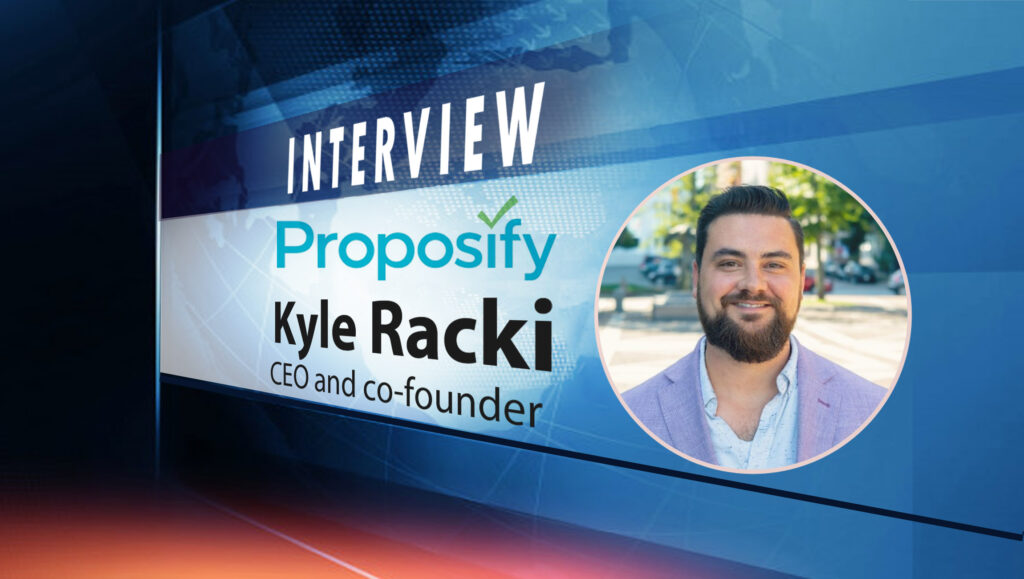Kyle Racki, Co-founder and CEO at Proposify highlights the top challenges sales people face by not automating the right tasks in time in this quick chat: ______ I began my career in the early 2000s as a web designer and developer. I worked at a few marketing agencies before founding my own in 2008 at the age of 24. Throughout that time, I struggled with the process of collaborating on winning proposals and getting them out the door quickly to prospects, so I designed a software interface one night—primarily for my own amusement. Little did I know years later, we’d be here with thousands of paying customers. After a few years of running my agency and dabbling with software ideas, my business partner, Kevin Springer, and I decided to go all-in on the proposal software concept. We hired a developer to build the first version of the product, sold our agency and raised seed capital to get Proposify off the ground. In late 2014 we began to see significant traction and started scaling the company to meet the demand of customers. I think at its worst, sales automation results in a lot of canned, robotic interactions with prospects. It’s allowing reps to get in more volume at plummeting engagement rates. The goal of automation is to eliminate manual tasks that don’t require personalization, and unfortunately, we’re seeing reps send out blasts with the exact same message to hundreds of thousands of contacts. However, there is a place for automation, and that’s when it is improving the customer experience, whether it’s getting a useful message at the right time in the buying journey, a proposal in their hands faster or being able to book a demo right on the calendar instead of waiting for a rep to reach out. Proposals. I’ve been in this space for almost ten years and I still see so many sales teams struggle with them. Most sales teams are putting all of their budget into the top of the funnel — more leads, better leads, more engagement, better qualification — and ignoring the bottom of the funnel – when the prospect signs your agreement and agrees to do business with you. Sales teams have settled on a 20-30% opportunity to close rate and with the automation in place, we should be aiming higher. We still live in a world where it can be like pulling teeth to get customized pricing from a sales rep, or a contract with terms and conditions. Buyers are more in control than ever before, and sales teams are fumbling deals at the finish line because they can’t automate the proposal, pricing, contract and negotiation ie: the closing stage of the deal. To start, I think the core purpose of automation is to do more in less time, to benefit all parties involved. Internally if you are automating proposals, contracts, and pricing, it means your reps spend less time on administrative tasks and more time selling. But externally, it also means prospects get the proposal in their hands faster, when they’re in a hot, ready-to-buy state. I believe the three core parts of the process that improve the buying experience for prospects are: Interactive pricing – Instead of static pricing, offer multiple options for the client to pick from, allow them to turn on and off optional fees and play with the amounts to customize their package. Video – People using videos embedded in the proposal are up 31% from last year and those who are using video in customer and sales conversations have increased 93%. This is a great tactic for presenting the proposal to stakeholders who haven’t been involved in the proposal process. Digital forms, e-signatures and payments – E-signatures alone can speed up time-to-close by 60%. I am fascinated by the concept of utilizing age-old consumer psychology to drive B2B sales and augmenting it with real-time data. Platforms of the future are going to allow for greater personalization at scale. Secondly, they will track even more information, using machine learning to analyze an incredible amount of data, then leverage it to offer up insights based on real-time buyer information. The products that win will focus less on “doing more stuff” and more on doing the right thing, at the right time, that moves the deal forward. Most sales organizations have still not woken up to the fact people are still driving the buying decisions in companies, and thus, they are still influenced primarily by emotions when buying. Too many interactions are canned, pricing opaque and documents full of jargon. Too often no one at the company is tasked with overseeing the full cycle customer experience – they only look at it once a client is in the door, if at all. Sales and marketing leaders need to take a critical look at the complete buying experience and invest in tools like Vidyard, Chilipiper, Drift and Proposify to offer better experiences and personalization at scale. Read More: SalesTechStar Interview with Dana Bjornson, Chief Financial Officer, Mylo Proposify helps modern sales teams create, send, track, and e-sign winning proposals, contracts, and agreements. Kyle Racki is the Co-founder and CEO at Proposify.Hi Kyle, we’d love to hear about your journey through the years…and the story behind Proposify?
How are you seeing the impact of sales automation lead to an evolution of how sales teams function today?
What are some of the most common sales tasks / sales work flows that you don’t see enough sales teams automating?
In what ways do you feel sales leaders can optimize the closing experience for the customer?
How do you feel platforms such as this will evolve in future and what will drive demand for more innovations and what kind?
A few thoughts on what you feel today’s sales and marketing leaders need to do differently to stand out from the crowd.

Catch more tips from the latest episodes of The SalesStar Podcast!





















